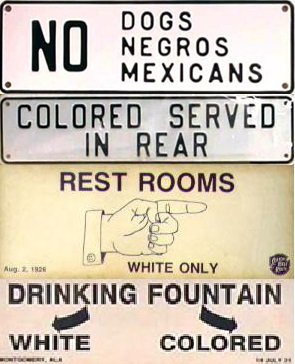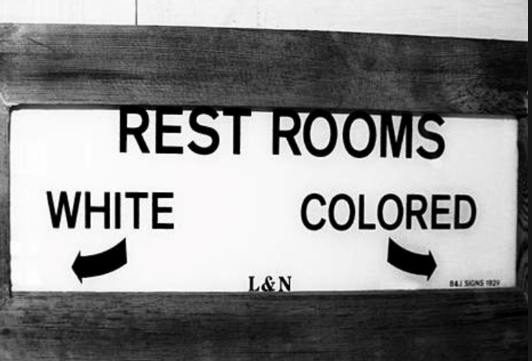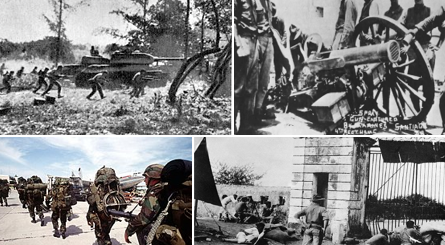Jim Crow Laws: List and History

Jim Crow laws caused great suffering and deaths to not just blacks but to all other non-whites across the United States of America. Image Source
Unlike the somewhat racially-tolerating America we see today, America’s past was full of racial prejudice and all sorts of discrimination. Back in those days, especially in the South, segregation laws partitioned public facilities according to races (skin color). This was known as the Jim Crow Law.
List of Jim Crow Laws
Going back to the period between 1880 and the 1960s, black folks (colored people) in many parts of the United States suffered under the hands of Jim Crow Laws. Virtually across the nation, in every corner, black Americans were perceived as second class citizens or even eyesores to white folks. The skin color of the black race was looked down upon.
To prevent close contact between whites and blacks, Jim Crow Laws were introduced to shame the dignity of African-Americans. An open violation of such a well-established law was tantamount to a fairly severe punishment. Offenders were either fined or sent to jail for misdemeanor.
The following are some of the Jim Crow Laws and the states that enforced them.
Barbering
In the state of Georgia, the laws made it clear that, it was highly offensive to whites for a black barber to attend to white customers (females). Under no condition could a “colored” barber offer services to white ladies. It was as simple as that, you either comply or you go to jail.
Public Washrooms

In Alabama, the Jim Crow law made it compulsory for all employers to provide separate bathrooms and toilet facilities for black and white workers. Without any good explanation, one can guess that blacks didn’t just belong to the class of whites.
Care for the Blind
Who would have thought that Jim Crow Laws wouldn’t be milder to visually-impaired black people? Believe it or not, in Louisiana separate care centers were allocated for blind people of dark skin. Even though, the blind people could not see, Jim Crow Laws could see that their skin color wasn’t appropriate to receive equal health care as the ones given to the whites. One can conclude that, “even though you can’t see me, I can see you”. Shocking! Isn’t it?
Public Transport
Bus seats were segregated in the South according to races. Colored occupants of vehicles were required to sit at the rear sections of buses. When a black woman by name Rosa Parks stubbornly refused to give up her seat to a white passenger, she found herself in police custody.
The case became a famous legal dispute which resulted in the Montgomery Bus Boycott. Thanks to the intervention of Martin Luther King Jr., as well as other civil rights activists, the bus boycott helped stem the harsh effects of those discrimination laws.
Education (Schools)

Jim Crow Laws in education
It was a normal thing in the South – schools were racially-segregated. During the active slave trade (prior to the American Civil War), it was completely illegal for black slaves to attend schools. When African Americans later had the chance to go to school, Jim Crow Laws prevented them from sitting in the same classroom with white students.
Social Jim Crow Laws
Not all the Jim Crow Laws were officially stated. Some white folks used their false perception of superiority to look down on black people at every least chance. For instance, black men who excelled in their businesses were subjected to very harsh treatments. It was not uncommon for black businesses to be set ablaze by jealous white supremacists. At the workplaces, black women risked being sacked from their jobs, if they failed to make way for white workers to pass.
Marriage and Relationships
By law, an inter-racial marriage between colored and white was not allowed. A marriage between a Negro and white person could not be upheld in the court. In Florida, the law was very strict on cohabitation. It was punishable by Jim Crow Laws, if a black person spent a night in the same room with a white partner. The minimum penalty was to sentence both culprits to 1-year imprisonment or worse they would each be fined not more than $ 500.
Housing

A picture depicting just how deeply offensive and inhumane Jim Crow Laws were to blacks in the housing sector
The biggest bite of the Jim Crow Laws was felt in the housing sector. In Louisiana, real estate providers were not allowed to rent buildings with black tenants to whites. In reverse, it was also considered a crime to rent a white-occupied building to a black person. Violation of such a known law could send one to jail.
The “Separate But Equal Policy”
The segregation laws were officially implemented after the Civil War and Reconstruction era (1865- 1877). At the law courts, racial discrimination cases were treated with injustice. The Jim Crow Laws came with the so-called “separate but equal policy“. This meant that, the separate facilities for whites and blacks were supposed to be equal in quality. But was that actually the case? Never! Hospitals, restaurants, prisons (and many other things) for the blacks, were known to be substandard. So basically, the Supreme Court hid behind the unrealistic “separate but equal” policy to justify the fairness of the Jim Crow Laws.
Origination of the “Jim Crow” Terminology

The first known usage of “Jim Crow” as a character is attributed to Thomas Dartmouth Rice.
Jim Crow has a rather interesting, but racially derogatory history. What does Jim Crow actually mean? Well, the term came from a minstrel character. Minstrels were a group of white performers who used to wear black makeup for their variety shows. The first known usage of “Jim Crow” as a character is attributed to Thomas Dartmouth Rice. He was a white traveling actor. Thomas would intentionally wear shabby black costume to make mockery of black people. Even though Thomas wasn’t the only white actor who wore rags and blackface, he was infamously known to have used a lot of derogatory and slurry terms against the blacks.
Thomas was the first actor who introduced “Jim Crow” as a character in a play titled “The Kentucky Rifle”. He displayed absurd dance moves as he sang “Jump Jim Crow”. Jim Crow was portrayed as a stupid character (a buffoon).
The character definition of Jim Crow became a stereotype of black folks. Many white actors then jumped onto the bandwagon of Jim Crow and used it for their shows. To white supremacists and racists such as the ones from the Ku Klux Klan (KKK), Jim Crow was a perfect term that fitted the discriminatory laws in the South. Hence Jim Crow Laws were born.
It took years of black civil rights activism, primarily in the 1950s and 1960s, before Jim Crow Laws were abolished.
FACT CHECK: At worldhistoryedu.com, we strive for utmost accuracy and objectivity. But if you come across something that doesn’t look right, don’t hesitate to leave a comment below.




























All the “JIM CROW” remarks that I have heard “nothing is said about Presidents being ousted for poor judgement of “NATIONAL CONCERNS for The UNITED STATES of AMERICA. The Presidents use of The Jim Crow law “TERM” is misused and out of date really or am I wrong. Can a President be Removed from office under”THE JIM CROW LAWS”? I am not up on so much of the Laws but I ask and I wait to be answered.